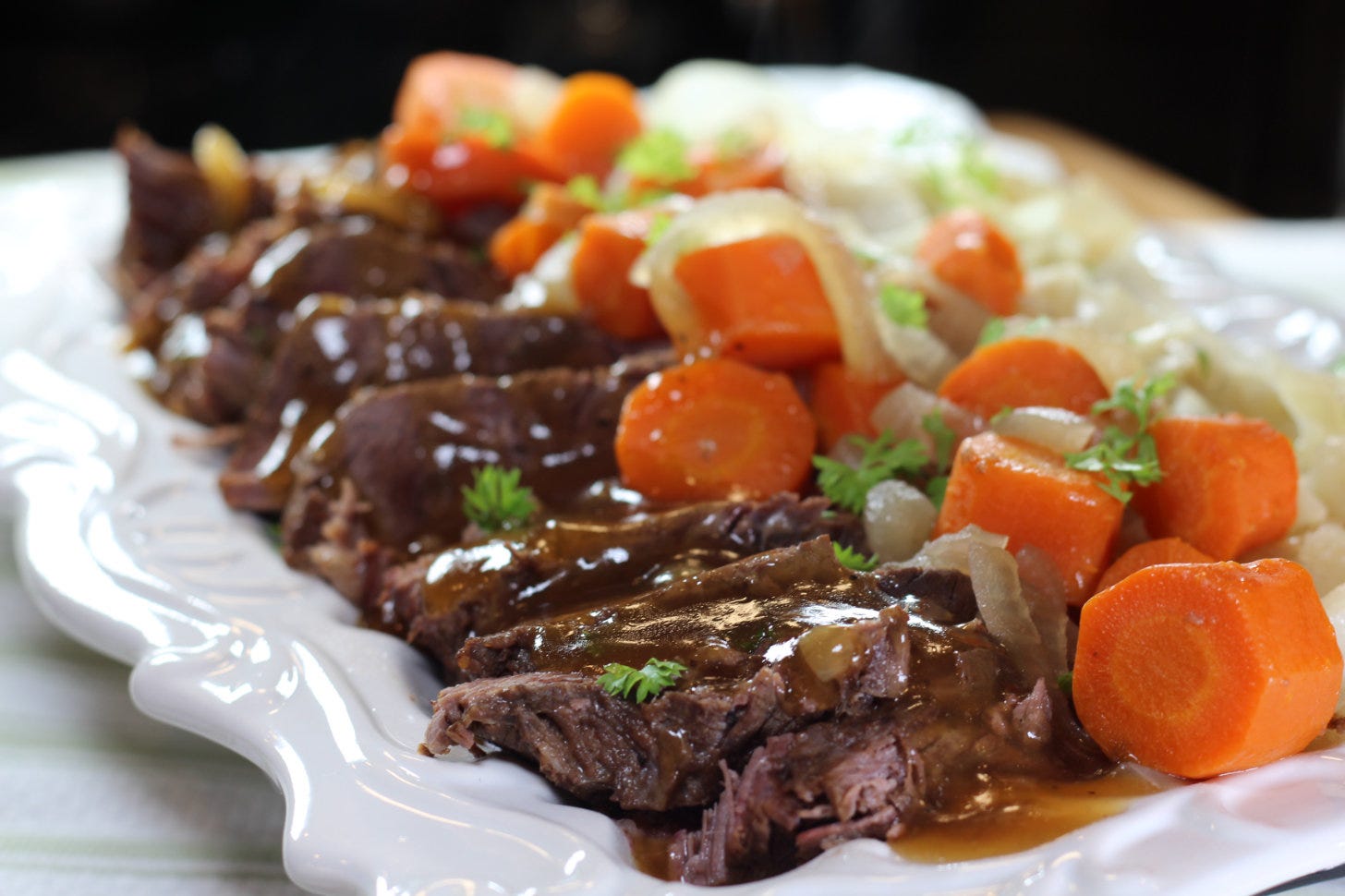Corned Beef Brisket with Carrots, Onion, and Cabbage - LFN #030
+ My Signature Pickling Spice Blend Recipe with How to Make Your Own, and A Bit About Prague Powder... (Right here, keep scrolling 👇)
Welcome to this week’s installment of Living Fully Nourished, where we’re getting ready for St. Patrick’s Day. We'll discuss some St. Paddy’s Day history and share my recipe for making corned beef at home. Plus more… You won’t want to miss this one!
Corned Beef Brisket with Carrots, Onion, and Cabbage
I’ve put a lot into pulling together this week’s recipe for Corned Beef Brisket with Carrots, Onion, and Cabbage. The post and recipe are just for my subscribers, so while you won’t find it on the blog, you’ll get everything here to make it in your kitchen successfully.
Let’s Get Started with A Little History
A traditional dish for St. Patrick’s Day in the United States, especially among Irish Americans, Corned beef and cabbage can be traced back to Irish immigrants in the United States in the late 19th and early 20th centuries when mass migration to the U.S. brought Irish communities into Jewish-American neighborhoods. But while the dish is widely associated with the Irish, it turns out that it isn’t on the menu in Ireland – they’re bigger on pork than beef. So, in contrast, the traditional dish for St. Patrick’s Day is actually bacon and cabbage.
Of course, if you’re in Ireland, you’d enjoy bacon and cabbage with a pint, two or maybe even three of (non-green) Guinness, or other distilled spirits like Irish whiskey (always spelled with an “e” in the word whiskey – a historical debate for another time). But that, too, wasn’t always the case. In fact, St. Patrick’s Day has been a religious holiday for centuries that involves much more sobriety than wild gatherings involving excessive drinking and promiscuity. And, still today, I’m told (because I’ve never been) that many of the pubs are closed on St. Patrick’s Day, and everyone goes to church.
You may also find it interesting that Ireland has long been known for making and sending out corned beef, but oddly enough, historically, most Irish have never tasted it. Back in the old days, cows were precious assets, like having money in a savings account. They were mainly kept for milk and work and only ended up on the dinner table reluctantly, on rare occasions when they were well past their prime.
So, even though the cows were way past their best years, most people were all about milk, grains, and bacon. Only the rich folks could afford to chow down on beef. And get this: the first mention of corned beef was in this old poem from (way back) in the 12th century, when they were teasing King Cathal Mac Finguine, known for being a glutton.
Oh my, as is my habit, I digress down another rabbit (er, trivia) hole again.
Back to corned beef and Irish immigrants arriving in America following famines in the 1800s.
The Irish found that beef was the meat they could more readily get their hands on. Beef was also cheaper than pork, and cured brisket was commonplace. Therefore, the Irish immigrants adapted their traditional dish to include corned beef instead of bacon.
I know I’m getting older, but somewhat later than the 1800s (when I was growing up way back in the ‘60s)…
My mom could be counted on to serve corned beef at least once a year in mid-March. I always thought it was our family’s way of connecting with the Saint Paddy’s Day American traditions. Little did I know, back then, that the main ingredient to our traditional corned beef and cabbage was also a part of the potpourri of American, or maybe I should say, Irish German English American heritage deep in my genetic makeup.
Irish or not - corned beef is preserved beef, typically made from brisket, and is first cured in a brine solution with a combination of salt, sugar, and spices, giving the meat its distinctive flavor and pink color. The name “corned beef” comes from the large grains of salt used in the curing process, known as “corns.” This technique not only enhances the flavor of the beef but also acts as a method of preservation, allowing the meat to be stored for an extended period, making it an ideal choice for immigrant families often living in poorer conditions.
Over time, corned beef and cabbage became associated with St. Patrick’s Day in America as a way to celebrate Irish heritage and culture. Today, many people enjoy this dish as part of their St. Patrick’s Day festivities, even though you could say it’s authentically Irish-Jewish-American!
How to Serve Corned Beef
Corned beef is a versatile ingredient that can be served and eaten in various ways. You can dish it up straight from the crockpot, serving it with buttered parsley potatoes and veggies, or slice it thin for Reuben sandwiches or to add protein to salads. In our family, it also stretched the budget, with the corned beef cut or shaved into thin bits swimming in milk gravy ladled over toast for a dish my dad called “S*it on a Shingle” or for making Corned Beef in Hash that could be eaten for breakfast, lunch, or dinner.
No matter how you enjoy it, it’s a budget-friendly staple and ingredient perfect for many traditional dishes, including the famous corned beef and cabbage, which many people associate with St. Patrick’s Day celebrations.
So, let’s get started making it!
How to Make Corned Beef Brisket with Carrots, Onions, and Cabbage
Ingredients
2-3 pound Beef Brisket
For Brining
3 tablespoons Steak Rub
3 tablespoons Hot Sauce
1/4 cup Kosher Salt or Prague Powder #1 (a.k.a. Pink Curing Salt #1 – optional to give the meat its characteristic pink color) [See footnote - 1 in my Kitchen Notes]
¼ cup Brown Sugar
¼ cup Pickling Spice, any gluten-free store-bought blend, or make your own [See footnote - 2 in my Kitchen Notes]
For Cooking
2 teaspoons Steak Rub
2 tablespoons Olive Oil
1 cup Beef stock
1 cup gluten-free Beer [See footnote -3 in my Kitchen Notes]
2 Bay leaves
2 Garlic cloves, minced
Carrots, onions, and potatoes as you wish
Salt and Pepper
1 medium head of Cabbage, sliced
Instructions
Please see the photo references below (L-R) notes by row and number before the step.
Corning the Beef
Row 1, photo 1: Trim any excess fat (known as the fat cap) from the brisket (if necessary) to prepare it for brining. Set the meat aside until needed.
Row 1, photos 2 and 3: Place the brining ingredients into a large pot with 8 cups (1/2 gallon) water and boil. Immediately turn off the flame and cool the mixture for approximately 30 minutes to room temperature. Stirring will help cool it down.
Row 2, photo 1: Place the brisket into a container that will seal tightly and easily fit into your refrigerator. Add the cool brine, making sure that the liquid covers the brisket. Then seal the container and place it in the fridge to brine, setting for at least two days and up to 10 days.




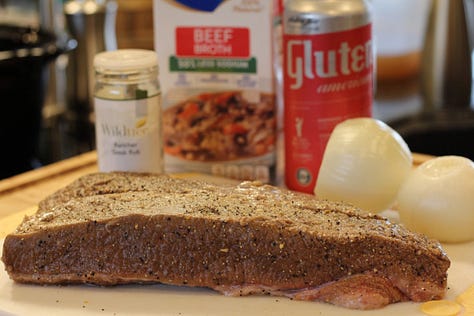
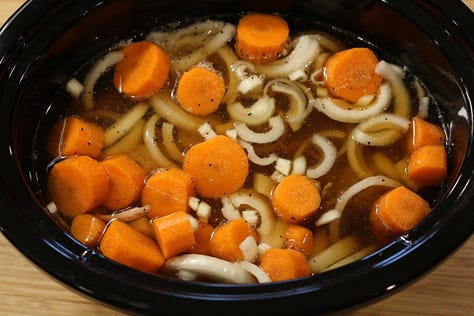
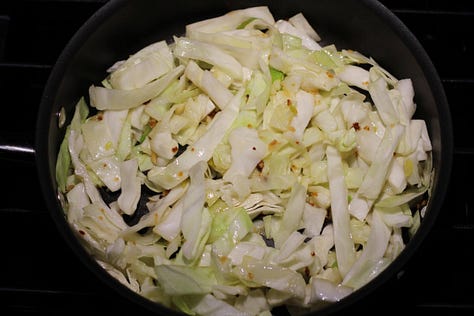
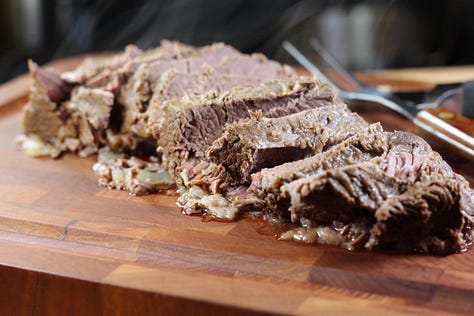
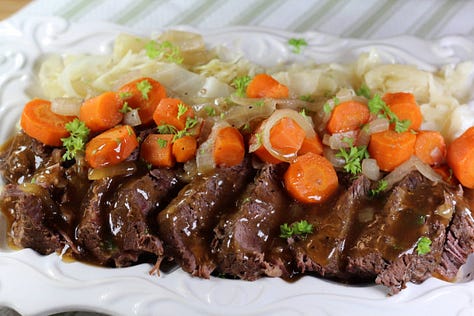
To Cook
Preheat the oven to 205° to 225°F. I include the temperature range because many ovens without digital capability may only have a 225°F setting.
Row 2, photo 2: Rinse all the brine from the corned beef with cool water. Pat and dry with a paper towel. Then, season the meat, sprinkling liberally with the steak rub.
Heat a heavy-bottom pot or Dutch oven (with a lid) over medium-high heat, drizzle the bottom of the pot with olive oil, and brown the meat on all sides. Add the beef stock, beer, bay leaves, and minced garlic. Cover and transfer to the oven, roast for three to five hours (depending on your brisket size) at (205° to 225°F). Alternatively, you could transfer it to a slow cooker to roast.
Row 2, photo 3: When the meat is fork-tender (the fork should slide in easily but not separate the meat - after cooking for about one hour per pound), add carrots, onions, and potatoes, sprinkling the top with salt and pepper—roast for one more hour.
Check the brisket and potatoes (if included) for doneness. The meat should easily separate when a fork is inserted, and the potatoes should easily be pierced.
Row 3, photo 1: Add the cabbage, cover, and cook for 30-45 minutes until tender but not mushy.
Row 3, photos 2 and 3: Remove the meat to a cutting board and slice. Transfer the meat and vegetables to a warm platter, topping the meat with stock (or gravy) to keep it moist. Serve plated family style with bread or rolls and grainy mustard alongside. Enjoy!
For your ultimate recipe success, I encourage you to read the KITCHEN NOTES included in my write-up below before beginning. The “Kitchen Notes” include all the details you need to know about making the recipe, including:
Corned Beef Brisket With Carrots, Onions & Cabbage Recipe - 8.5x11 Printable Recipe Download
Differences between the brisket flat and brisket point areas.
What temperature is the corned beef done?
My notes about flavor and size.
Curing Salt — Options for preserving meats.
About the Pickling Spice - (With recipe download links)
Making your Own Pickling Spice Blend
My signature pickling spice blend recipe.
Basic Pickling Spices to Include
Optional Pickling Spices to Add
About the Two Gluten-Free Beers, I’ve Tried in This Recipe.
Keep reading with a 7-day free trial
Subscribe to Live Fully Nourished @GfreeDeliciously to keep reading this post and get 7 days of free access to the full post archives.





